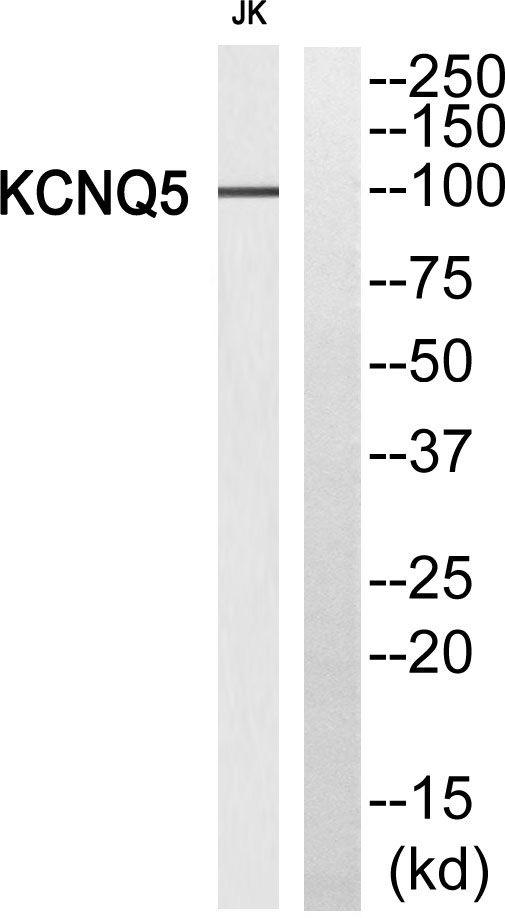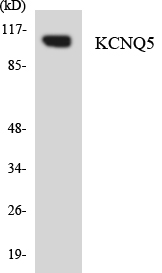产品名称
KCNQ5 Rabbit Polyclonal Antibody
别名
KCNQ5; Potassium voltage-gated channel subfamily KQT member 5; KQT-like 5; Potassium channel subunit alpha KvLQT5; Voltage-gated potassium channel subunit Kv7.5
蛋白名称
Potassium voltage-gated channel subfamily KQT member 5
存储缓冲液
Liquid in PBS containing 50% glycerol, 0.5% BSA and 0.02% New type preservative N.
Human Gene Link
http://www.ncbi.nlm.nih.gov/sites/entrez?db=gene&term=56479
Human Swissprot No.
Q9NR82
Human Swissprot Link
http://www.uniprot.org/uniprotkb/Q9NR82/entry
Mouse Gene Link
http://www.ncbi.nlm.nih.gov/sites/entrez?db=gene&term=226922
Mouse Swissprot No.
Q9JK45
Mouse Swissprot Link
http://www.uniprot.org/uniprot/Q9JK45
免疫原
The antiserum was produced against synthesized peptide derived from human KCNQ5. AA range:637-686
特异性
KCNQ5 Polyclonal Antibody detects endogenous levels of KCNQ5 protein.
稀释度
WB 1:500-2000;IHC-p 1:50-300; ELISA 2000-20000
宿主
Polyclonal, Rabbit,IgG
背景介绍
This gene is a member of the KCNQ potassium channel gene family that is differentially expressed in subregions of the brain and in skeletal muscle. The protein encoded by this gene yields currents that activate slowly with depolarization and can form heteromeric channels with the protein encoded by the KCNQ3 gene. Currents expressed from this protein have voltage dependences and inhibitor sensitivities in common with M-currents. They are also inhibited by M1 muscarinic receptor activation. Multiple transcript variants encoding different isoforms have been found for this gene. [provided by RefSeq, May 2009],
组织表达
Strongly expressed in brain and skeletal muscle. In brain, expressed in cerebral cortex, occipital pole, frontal lobe and temporal lobe. Lower levels in hippocampus and putamen. Low to undetectable levels in medulla, cerebellum and thalamus.
细胞定位
Cell membrane ; Multi-pass membrane protein .
功能
domain:The segment S4 is probably the voltage-sensor and is characterized by a series of positively charged amino acids at every third position.,function:Probably important in the regulation of neuronal excitability. Associates with KCNQ3 to form a potassium channel which contributes to M-type current, a slowly activating and deactivating potassium conductance which plays a critical role in determining the subthreshold electrical excitability of neurons. May contribute, with other potassium channels, to the molecular diversity of an heterogeneous population of M-channels, varying in kinetic and pharmacological properties, which underlie this physiologically important current. Insensitive to tetraethylammonium, but inhibited by barium, linopirdine and XE991. Activated by niflumic acid and the anticonvulsant retigabine. Muscarine suppresses KCNQ5 current in Xenopus oocytes in which cloned KCNQ5 channels were coexpressed with M(1) muscarinic receptors.,similarity:Belongs to the potassium channel family. KQT subfamily.,subunit:Heteromultimer with KCNQ3.,tissue specificity:Strongly expressed in brain and skeletal muscle. In brain, expressed in cerebral cortex, occipital pole, frontal lobe and temporal lobe. Lower levels in hippocampus and putamen. Low to undetectable levels in medulla, cerebellum and thalamus.,
纯化
The antibody was affinity-purified from rabbit antiserum by affinity-chromatography using epitope-specific immunogen.


